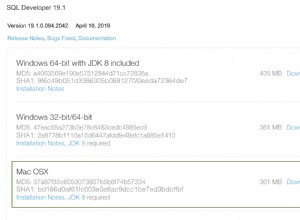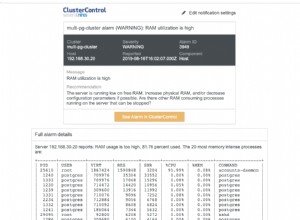Ten kod jest dość długi. Przepraszam. Składa się z dwóch procedur składowanych. Możesz być zadowolony z uruchomienia tylko pierwszego. Drugi wykorzystuje dane wyjściowe z pierwszego (dane, które pierwszy pozostawił w tabelach). Możesz również chcieć połączyć kod w jeden. Ale trzymałem je osobno. Drugi przechowywany proc tworzy dane wyjściowe przypominające describe myTable . Ale wykonuje to dla WSZYSTKICH tabele w bazie danych, których potrzebujesz.
Używasz tego, przekazując parametr (ciąg znaków) do bazy danych, o której ma być raportowany.
Tworzę oddzielną bazę danych, a kod wyraźnie odwołuje się do tabel w tej bazie danych według nazwy. Więc jeśli masz EXECUTE uprawnienia do tej procedury składowanej, można ją uruchomić z dowolnej bieżącej bazy danych. W ramach prostego testu nie należy więc ustawiać bazy danych raportowania jako bieżącej bazy danych, a jedynie wywołać procedurę składowaną według nazwy (kwalifikującej się nazwą bazy danych raportowania). Wszystko to pokazano w części testowej poniżej.
Dwie zapisane procedury
CREATE SCHEMA Reporting101a; -- See **Note1**
DROP PROCEDURE IF EXISTS `Reporting101a`.`describeTables_v2a`;
DELIMITER $$
CREATE DEFINER=`root`@`localhost` PROCEDURE `Reporting101a`.`describeTables_v2a`(
IN dbName varchar(100), -- the dbname to report table structures
OUT theSession int, -- OUT parameter for session# assigned
IN deleteSessionRows BOOL, -- true for delete rows when done from main reporting table for this session#
IN callTheSecondStoredProc BOOL -- TRUE = output is from Pretty output in Second Stored Proc. FALSE= not so pretty output
)
BEGIN
DECLARE thisTable CHAR(100);
DROP TEMPORARY TABLE IF EXISTS Reporting101a.tOutput;
CREATE TEMPORARY TABLE Reporting101a.tOutput
( id int auto_increment primary key,
tblName varchar(100) not null,
ordVal int not null,
cField varchar(100) not null,
cType varchar(100) not null,
cNull varchar(100) not null,
cKey varchar(100) not null,
cDefault varchar(100) null,
cExtra varchar(100) null
);
DROP TEMPORARY TABLE IF EXISTS Reporting101a.tOutput2;
CREATE TEMPORARY TABLE Reporting101a.tOutput2
( tblName varchar(100) primary key,
colCount int not null,
cFieldMaxLen int not null,
cTypeMaxLen int not null,
cNullMaxLen int not null,
cKeyMaxLen int not null,
cDefaultMaxLen int not null,
cExtraMaxLen int not null
);
INSERT Reporting101a.tOutput(tblName,ordVal,cField,cType,cNull,cKey,cDefault,cExtra)
SELECT TABLE_NAME,ORDINAL_POSITION,COLUMN_NAME AS Field, COLUMN_TYPE AS TYPE, RPAD(IS_NULLABLE,4,' ') AS 'Null',
RPAD(COLUMN_KEY,3,' ') AS 'Key',RPAD(COLUMN_DEFAULT,7,' ') AS 'DEFAULT',EXTRA AS Extra
FROM information_schema.columns WHERE table_schema = dbName ORDER BY table_name,ordinal_position;
-- select * from information_schema.columns WHERE table_schema = '57security' order by table_name,ordinal_position;
UPDATE Reporting101a.tOutput
SET cExtra=' '
WHERE cExtra='';
UPDATE Reporting101a.tOutput
SET cField=RPAD(cField,5,' ')
WHERE LENGTH(cField)<5;
INSERT Reporting101a.tOutput2(tblName,colCount,cFieldMaxLen,cTypeMaxLen,cNullMaxLen,cKeyMaxLen,cDefaultMaxLen,cExtraMaxLen)
SELECT tblName,COUNT(*),0,0,0,0,0,0
FROM Reporting101a.tOutput
GROUP BY tblName;
UPDATE tOutput2 t2
JOIN
( SELECT tblName,MAX(LENGTH(cField)) AS mField,MAX(LENGTH(cType)) AS mType,MAX(LENGTH(cNull)) AS mNull,
IFNULL(MAX(LENGTH(cKey)),0) AS mKey,IFNULL(MAX(LENGTH(cDefault)),0) AS mDefault,IFNULL(MAX(LENGTH(cExtra)),0) AS mExtra
FROM Reporting101a.tOutput
GROUP BY tblName
) x
ON x.tblName=t2.tblName
SET t2.cFieldMaxLen=x.mField,t2.cTypeMaxLen=x.mType,cNullMaxLen=x.mNull,
cKeyMaxLen=x.mKey,cDefaultMaxLen=x.mDefault,cExtraMaxLen=x.mExtra;
-- DROP TABLE Reporting101a.reportDataDefsSession; -- useful for quick change of structure of table
-- note, keep above drop call remmed out ! Just use it for quick tweaks to structure
CREATE TABLE IF NOT EXISTS Reporting101a.reportDataDefsSession
( -- for the sole purpose of safe session auto_inc usage
-- Please don't delete unless you want the sessions to experience aberant behavior
sessionId INT AUTO_INCREMENT PRIMARY KEY,
dummy CHAR(1) NOT NULL,
creationDT datetime not null
);
CREATE TABLE IF NOT EXISTS Reporting101a.reportDataDefs
( sessionId INT NOT NULL,
tblName VARCHAR(100) NOT NULL, -- Tablename
ordVal INT NOT NULL, -- the "position number" of the Column
cField VARCHAR(100) NOT NULL, -- The Column
cType VARCHAR(100) NOT NULL, -- Datatype
cNull VARCHAR(100) NOT NULL, -- Nullability
cKey VARCHAR(100) NOT NULL, -- Key info
cDefault VARCHAR(100) NULL, -- Default value
cExtra VARCHAR(100) NULL, -- Extra output
colCount INT NOT NULL, -- the columns here and below are de-normalize data
cFieldMaxLen INT NOT NULL,
cTypeMaxLen INT NOT NULL,
cNullMaxLen INT NOT NULL,
cKeyMaxLen INT NOT NULL,
cDefaultMaxLen INT NOT NULL,
cExtraMaxLen INT NOT NULL
);
-- For lack of a better notion, we are calling calls "sessions". The programmer calls the
-- First Stored Proc, and we call that a session after we get a unique next incrementing number.
-- That number is the session #. House all output with that as a column value. This allows us to
-- move between stored procs, have safe output, have historical snapshots, and retain the data
-- via a session # for later use, whatever use.
INSERT Reporting101a.reportDataDefsSession(dummy,creationDT) VALUES ('X',now());
SET @mySession=LAST_INSERT_ID(); -- there it is, our session # (read the above paragraph)
INSERT Reporting101a.reportDataDefs(sessionId,tblName,ordVal,cField,cType,cNull,cKey,cDefault,cExtra,
colCount,cFieldMaxLen,cTypeMaxLen,cNullMaxLen,cKeyMaxLen,cDefaultMaxLen,cExtraMaxLen)
SELECT @mySession,t1.tblName,t1.ordVal,t1.cField,t1.cType,t1.cNull,t1.cKey,t1.cDefault,t1.cExtra,
t2.colCount,t2.cFieldMaxLen,t2.cTypeMaxLen,t2.cNullMaxLen,t2.cKeyMaxLen,t2.cDefaultMaxLen,t2.cExtraMaxLen
FROM Reporting101a.tOutput t1
JOIN Reporting101a.tOutput2 t2
ON t2.tblName=t1.tblName
ORDER BY t1.tblName,t1.id;
DROP TEMPORARY TABLE Reporting101a.tOutput;
DROP TEMPORARY TABLE Reporting101a.tOutput2;
SET [email protected]; -- the OUT var that came in as a parameter
-- ***************************************************************************
-- ***************************************************************************
-- Label "Some_Sort_of_Output":
IF callTheSecondStoredProc=TRUE THEN
-- The caller says to call the second stored proc (for Pretty Printing)
-- This will generate output similar to `DESCRIBE myTable`
-- But remember, it will do it for EVERY table in referenced database
CALL Reporting101a.`Print_Tables_Like_Describe`(@mySession);
-- The above call just gave you output.
ELSE
-- The caller chose to not auto call the Pretty Printing second stored procedure.
-- Note, the caller can easily call it right after using the OUT parameter.
-- So our output will be a resultset of out reportDataDefs table for this session #
SELECT *
FROM Reporting101a.reportDataDefs
WHERE [email protected]
ORDER BY tblName,ordVal;
END IF;
-- ***************************************************************************
-- ***************************************************************************
IF deleteSessionRows=TRUE THEN
-- The caller says output rows are NOT needed at this point. Delete them.
-- Note, if this boolean comes in TRUE, you can't call Pretty Printing
-- second stored procedure with the session # because the data is gone.
--
-- Regardless, you are getting something back from "Some_Sort_of_Output" above.
DELETE FROM Reporting101a.reportDataDefs
WHERE [email protected];
END IF;
END$$
DELIMITER ;
DROP PROCEDURE IF EXISTS `Reporting101a`.`Print_Tables_Like_Describe`;
DELIMITER $$
CREATE DEFINER=`root`@`localhost` PROCEDURE `Reporting101a`.`Print_Tables_Like_Describe`(
pSessionId INT
)
BEGIN
DECLARE done INT DEFAULT FALSE;
DECLARE curTable VARCHAR(100) DEFAULT '';
DECLARE bFirst BOOL DEFAULT TRUE;
DECLARE lv_tblName,lv_cField,lv_cType,lv_cNull,lv_cKey,lv_cDefault,lv_cExtra VARCHAR(100);
DECLARE lv_ordVal,lv_colCount,lv_cFieldMaxLen,lv_cTypeMaxLen,lv_cNullMaxLen,lv_cKeyMaxLen,lv_cDefaultMaxLen,lv_cExtraMaxLen INT;
DECLARE cur1 CURSOR FOR SELECT tblName,ordVal,cField,cType,cNull,cKey,cDefault,cExtra,
colCount,cFieldMaxLen,cTypeMaxLen,cNullMaxLen,cKeyMaxLen,cDefaultMaxLen,cExtraMaxLen
FROM Reporting101a.reportDataDefs
WHERE sessionId=pSessionId
ORDER BY tblName,ordVal;
DECLARE CONTINUE HANDLER FOR NOT FOUND SET done = TRUE;
-- Please note in the above, CURSOR stuff must come last else "Error 1337: Variable or condition decl aft curs"
CREATE TABLE IF NOT EXISTS Reporting101a.reportOutput
( lineNum INT AUTO_INCREMENT PRIMARY KEY,
sessionId INT NOT NULL,
lineOut varchar(100) NOT NULL
);
-- INSERT Reporting101a.reportOutput(sessionId,lineOut)
-- SELECT
-- SET curTable='';
DELETE FROM Reporting101a.reportOutput
WHERE sessionId=pSessionId;
OPEN cur1;
read_loop: LOOP
FETCH cur1 INTO lv_tblName,lv_ordVal,lv_cField,lv_cType,lv_cNull,lv_cKey,lv_cDefault,lv_cExtra,
lv_colCount,lv_cFieldMaxLen,lv_cTypeMaxLen,lv_cNullMaxLen,lv_cKeyMaxLen,lv_cDefaultMaxLen,lv_cExtraMaxLen ;
IF done THEN
LEAVE read_loop;
END IF;
IF lv_tblName<>curTable THEN
IF bFirst=FALSE THEN
INSERT Reporting101a.reportOutput(sessionId,lineOut)
SELECT pSessionId,'';
ELSE
SET bFirst=FALSE;
END IF;
INSERT Reporting101a.reportOutput(sessionId,lineOut)
SELECT pSessionId,lv_tblName;
INSERT Reporting101a.reportOutput(sessionId,lineOut)
SELECT pSessionId,CONCAT('+-',
REPEAT('-',GREATEST(5,lv_cFieldMaxLen)), '-+-',
REPEAT('-',GREATEST(4,lv_cTypeMaxLen)), '-+-',
REPEAT('-',GREATEST(4,lv_cNullMaxLen)), '-+-',
REPEAT('-',GREATEST(3,lv_cKeyMaxLen)), '-+-',
REPEAT('-',GREATEST(7,lv_cDefaultMaxLen)), '-+-',
REPEAT('-',GREATEST(5,lv_cExtraMaxLen)), '-+');
SET @dashLineNumRow=LAST_INSERT_ID();
INSERT Reporting101a.reportOutput(sessionId,lineOut)
SELECT pSessionId,CONCAT('| ',
'Field',
REPEAT(' ',GREATEST(0,lv_cFieldMaxLen-5)), ' | ',
'Type',
REPEAT(' ',GREATEST(0,lv_cTypeMaxLen-4)), ' | ',
'Null',
REPEAT(' ',GREATEST(0,lv_cNullMaxLen-4)), ' | ',
'Key',
REPEAT(' ',GREATEST(0,lv_cKeyMaxLen-3)), ' | ',
'Default',
REPEAT(' ',GREATEST(0,lv_cDefaultMaxLen-7)), ' | ',
'Extra',
REPEAT(' ',GREATEST(0,lv_cExtraMaxLen-5)), ' |');
INSERT Reporting101a.reportOutput(sessionId,lineOut)
SELECT pSessionId,lineOut
FROM Reporting101a.reportOutput
WHERE [email protected];
-- SELECT * FROM Reporting101a.reportDataDefs WHERE sessionId=24;
SET curTable=lv_tblName;
END IF;
INSERT Reporting101a.reportOutput(sessionId,lineOut)
SELECT pSessionId,
CONCAT('| ',
COALESCE(lv_cField,''),
COALESCE(REPEAT(' ',GREATEST(0,lv_cFieldMaxLen-LENGTH(lv_cField))),''),' | ',
COALESCE(lv_cType,''),
COALESCE(REPEAT(' ',GREATEST(0,lv_cTypeMaxLen-LENGTH(lv_cType))),''),' | ',
COALESCE(lv_cNull,''),
COALESCE(REPEAT(' ',GREATEST(0,lv_cNullMaxLen-LENGTH(lv_cNull))),''),' | ',
COALESCE(lv_cKey,' '),
COALESCE(REPEAT(' ',GREATEST(0,lv_cKeyMaxLen-LENGTH(lv_cKey))),''),' | ',
COALESCE(lv_cDefault,' '),
COALESCE(REPEAT(' ',GREATEST(0,lv_cDefaultMaxLen-LENGTH(lv_cDefault))),''),' | ',
COALESCE(lv_cExtra,' '),
COALESCE(REPEAT(' ',GREATEST(0,lv_cExtraMaxLen-LENGTH(lv_cExtra))),''),' |');
INSERT Reporting101a.reportOutput(sessionId,lineOut)
SELECT pSessionId,lineOut
FROM Reporting101a.reportOutput
WHERE [email protected];
END LOOP;
CLOSE cur1;
select lineOut as '' from Reporting101a.reportOutput where sessionId=pSessionId order by lineNum;
END$$
DELIMITER ;
Test
Test:
-- See **Note2**
SET @theOutVar =-1; -- A variable used as the OUT variable below
-- See **Note3**
-- Note: with `TRUE` as the 4th parameter, this is a one call deal. Meaning, you are done.
call Reporting101a.describeTables_v2a('stackoverflow',@theOutVar,false,true);
-- See **Note4**
-- Primarily used if the 4th parameter above is false
call Reporting101a.Print_Tables_Like_Describe(@theOutVar); -- loads data for prettier results in chunk format.
Wyjście
+--------------------------------------------------------------------------------------------+
| |
+--------------------------------------------------------------------------------------------+
| course |
| +------------+--------------+------+-----+---------+----------------+ |
| | Field | Type | Null | Key | Default | Extra | |
| +------------+--------------+------+-----+---------+----------------+ |
| | courseId | int(11) | NO | PRI | | auto_increment | |
| +------------+--------------+------+-----+---------+----------------+ |
| | deptId | int(11) | NO | MUL | | | |
| +------------+--------------+------+-----+---------+----------------+ |
| | courseName | varchar(100) | NO | | | | |
| +------------+--------------+------+-----+---------+----------------+ |
| |
| dept |
| +----------+--------------+------+-----+---------+----------------+ |
| | Field | Type | Null | Key | Default | Extra | |
| +----------+--------------+------+-----+---------+----------------+ |
| | deptId | int(11) | NO | PRI | | auto_increment | |
| +----------+--------------+------+-----+---------+----------------+ |
| | deptName | varchar(100) | NO | | | | |
| +----------+--------------+------+-----+---------+----------------+ |
| |
| scjunction |
| +------------+---------+------+-----+---------+----------------+ |
| | Field | Type | Null | Key | Default | Extra | |
| +------------+---------+------+-----+---------+----------------+ |
| | id | int(11) | NO | PRI | | auto_increment | |
| +------------+---------+------+-----+---------+----------------+ |
| | studentId | int(11) | NO | MUL | | | |
| +------------+---------+------+-----+---------+----------------+ |
| | courseId | int(11) | NO | MUL | | | |
| +------------+---------+------+-----+---------+----------------+ |
| | term | int(11) | NO | | | | |
| +------------+---------+------+-----+---------+----------------+ |
| | attendance | int(11) | NO | | | | |
| +------------+---------+------+-----+---------+----------------+ |
| | grade | int(11) | NO | | | | |
| +------------+---------+------+-----+---------+----------------+ |
| |
| student |
| +-----------+--------------+------+-----+---------+----------------+ |
| | Field | Type | Null | Key | Default | Extra | |
| +-----------+--------------+------+-----+---------+----------------+ |
| | studentId | int(11) | NO | PRI | | auto_increment | |
| +-----------+--------------+------+-----+---------+----------------+ |
| | fullName | varchar(100) | NO | | | | |
| +-----------+--------------+------+-----+---------+----------------+ |
| |
| testtable |
| +-----------------------------------------+---------------+------+-----+---------+-------+ |
| | Field | Type | Null | Key | Default | Extra | |
| +-----------------------------------------+---------------+------+-----+---------+-------+ |
| | noPKhere | int(11) | NO | | | | |
| +-----------------------------------------+---------------+------+-----+---------+-------+ |
| | veryLongColumnName_And_Then.Some_%_More | decimal(12,2) | YES | | | | |
| +-----------------------------------------+---------------+------+-----+---------+-------+ |
| | limit | int(11) | NO | | | | |
| +-----------------------------------------+---------------+------+-----+---------+-------+ |
| |
| testtable2 |
| +-------+---------+------+-----+---------+-------+ |
| | Field | Type | Null | Key | Default | Extra | |
| +-------+---------+------+-----+---------+-------+ |
| | id | int(11) | NO | PRI | | | |
| +-------+---------+------+-----+---------+-------+ |
+--------------------------------------------------------------------------------------------+
Uwaga1 :Baza danych o nazwie Reporting101a jest tworzony do przechowywania dwóch procedur przechowywanych i niektórych tabel pomocniczych. Te procedury zaczynają się od wywołania procedury składowanej odwołującej się do bazy danych, do której ma być raportowany za pomocą ciągu.
Dostęp do danych do wygenerowania danych wyjściowych uzyskuje się poprzez specjalny INFORMATION_SCHEMA bazy danych w bezpieczny sposób tylko do ODCZYTU. W związku z tym raportowana baza danych nie zostaje naruszona.
W tej bazie danych przechowywane są trzy tymczasowe tabele.
reportDataDefsSession- Prosta tabela służąca do uzyskania sesji#reportDataDefs- dane zwracane zINFORMATION_SCHEMAi trochę masować. Jest oparty na sesji.reportOutput- Tabela do drukowania, np.DESCRIBEMySQL . To tylko tabela do zestawienia wyników. Jest oparty na sesji.
Uwaga2 :To INT zmienna jest zawarta jako OUT parametr target, zapisany do i umożliwia wprowadzenie innego kodu po przygotowaniu danych przez pierwszą procedurę składowaną. Reprezentuje sesję #, która izoluje dane wyjściowe do późniejszego raportowania.
Niektóre środowiska, takie jak PHP, mają pewne sztuczki, które sprawiają, że jest to popisowe dla niektórych programistów. Więc jeśli chcesz samodzielnie połączyć obie procedury składowane, zrób to (lub poproś mnie o oddzielne, jeśli jesteś zdezorientowany).
W każdym razie pokazuje, w jaki sposób dane lub wysiłki mogą połączyć wywołania procedur składowanych.
Szczerze jednym z głównych powodów, dla których wychodzę z sesji # jako parametr OUT, jest to, że wiem, że muszę utworzyć CURSOR, aby uzyskać ładne dane wyjściowe. A to wymaga Cursor DECLARE
u góry drugiej procedury składowanej. I DECLARE s musi wystąpić na początku procedury składowanej. Więc ze związanymi rękami poszedłem tą drogą.
Uwaga3 :To jest wywołanie pierwszej procedury składowanej. Jest bardzo prawdopodobne, że zakończysz po tym wywołaniu, mając TRUE jako czwarty parametr. Procedura składowana jest w nim dość dobrze udokumentowana. Trzeci parametr określa, czy chcesz usunąć dane z tabeli raportowania dla sesji #. Usuwanie następuje po dowolnym wyjściu jako zestaw wyników. To zależy od Twojego wyboru.
Parametry:
- nazwa bazy danych opisująca wszystkie tabele, np.
describe myTable INTOUTparametr do przechowywania sesji #- boolean:czy chcesz usunąć dane z tabeli raportowania na końcu
- boolean:czy powinniśmy automatycznie wywołać ładną drukarkową procedurę składowaną, która generuje
describe-jak wyjście. Jeśli zdecydujesz się przekazać parametr 4 jakoFALSE, wynik może wyglądać tak:
Uwaga4 :Używane w przypadkach, gdy chcesz uzyskać inne wyjście, ale chcesz, aby sesja # działała. Zazwyczaj tego nie potrzebujesz.





